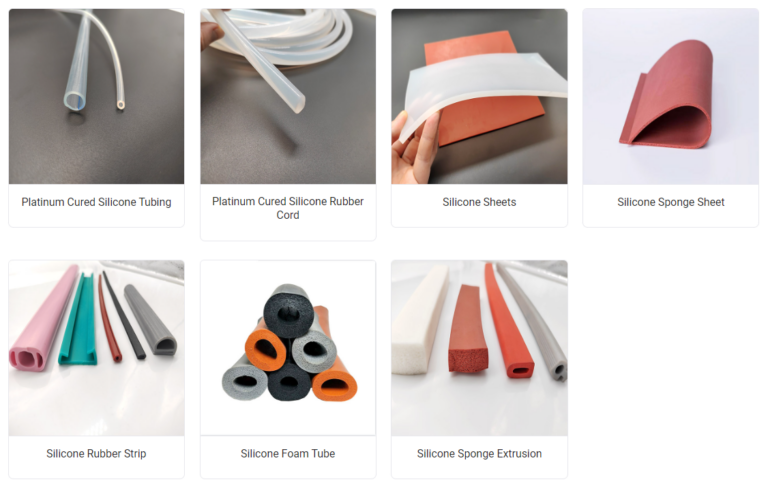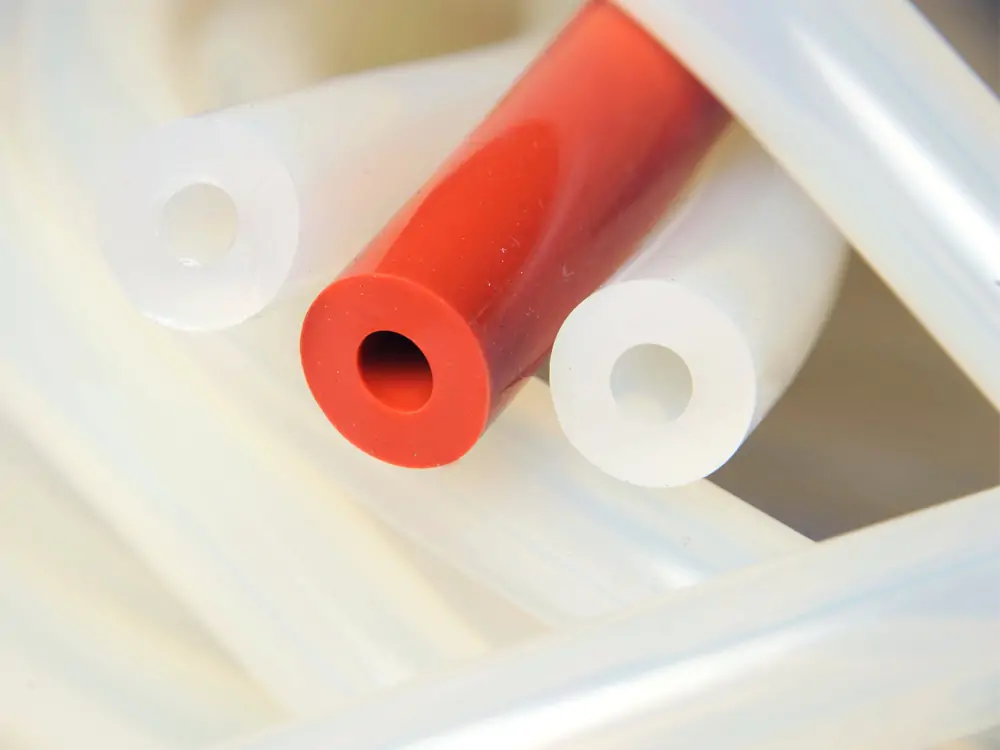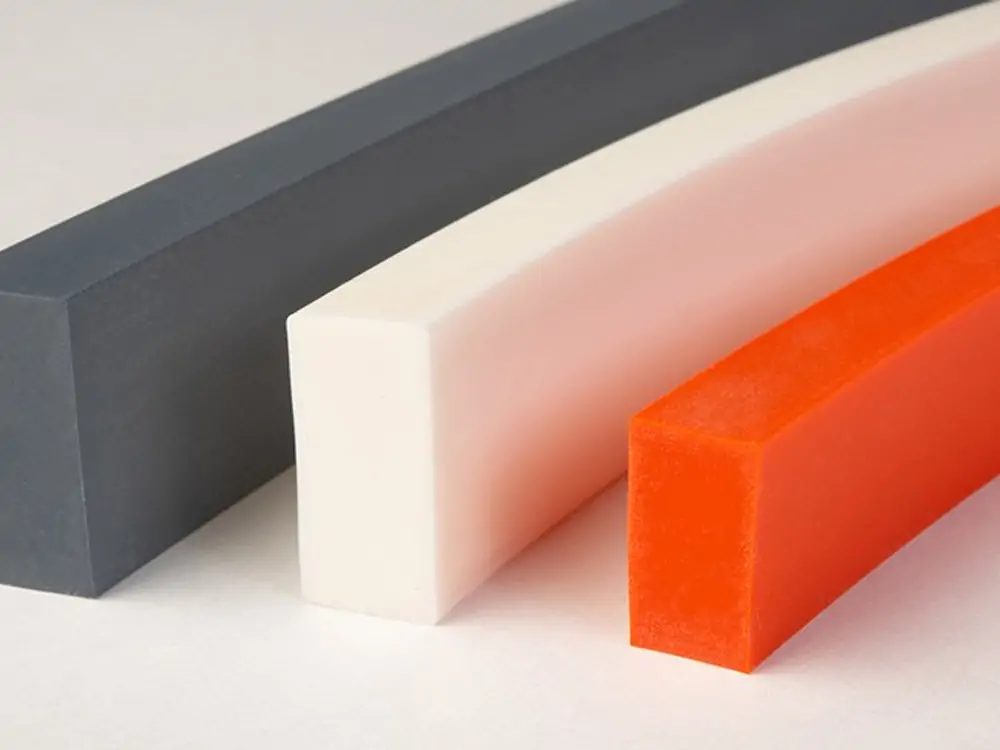When it comes to rubber, silicone rubber is one of a kind. It is famous for being very strong even in harsh situations. Because of its properties and ability to serve many purposes, silicone rubber is an excellent choice for numerous industries. It has become a staple choice in many areas, from medical advancement to automotive vehicles. Also, silicone rubber is often used to make seal strips.

Silicone elastomer has many good qualities, but it also has some limitations. When choosing a suitable material, it is best to consider all these things. This article is about the distinct types of silicone rubber, their applications, and their properties.
What is Silicone Rubber?
You may need to understand the difference between silicon & silicone.
Silicon is a chemical element with an atomic number of 14 and a symbol Si. It is widely used in electronics and semiconductors, including CPU motherboard chips, solar plates, and other electronic accessories.
Conversely, silicone is a synthetic polymer of silicone, oxygen, and hydrocarbons. It’s a flexible, rubber-like material discussed in this section.
Silicone rubber is famous because it has the qualities of both silicon and rubber. It’s very resistant to heat, cold, and surrounding damage, making it a good choice for many uses. You can find it in consumer goods, automobiles, medical equipment, and construction.
Si rubber comes in many forms and dimensions. You could make a gel, a resin, a liquid, or a rubber. You can prepare based on the application’s needs, no matter what it is. As a result, silicone rubber is also commonly used in other situations. Sealants, adhesives, lubricants, medical devices, cooking tools, and bakeware are a few examples.
How is Silicone Rubber Made?
Silicone is a flexible material that is used in many industrial settings. It goes through several steps in the making process. Here is a complete description of the five steps used to make silicone.
Step 1: Silicon Isolation from Silica
Silicon is the main ingredient in rubber. The first step in the process is to extract silicon from silica.
During this extraction process, several chemical reactions at high temperatures usually occur. People often call this process the reduction of silica. You already know that silica sand is made up of SiO2.
During the process, carbon is added to an electric arc furnace. This produces silicon and carbon monoxide gas, which is then refined again to achieve the desired purity level for silicone production.
Step 2: Combination of Silicon Powder with Methyl Chloride
After removing and cleaning the silicon, it is mixed with methyl chloride. The chemical formula for methyl chloride is CH3Cl. This is one of the crucial stages of making silicone rubber.
This mix usually takes place in a reaction vessel. Silicon and methyl chloride can react chemically better in a controlled setting. The product of this process is dimethyldichlorosilane, which is (CH3)2SiCl2. For silicone polymerization to happen, it needs first to be made.
Step 3: Mixture Distillation
The above mixture undergoes distillation in this stage. It typically separates and purifies the desired silicon compounds.
For this step, the mixture needs to be heated until it boils. It makes the parts evaporate, then the gas cools down and turns into liquid. This process typically isolates specific silicon compounds from the reaction mixture.
Step 4: Water Addition
Water is added to the clean silicon molecules after distillation. Adding water is the first step in the hydrolysis process.
Hydrolysis creates hydrochloric acid (HCl) and di-silanol (Si-OH). The creation of di-silanol is necessary for the polymerization of silicone to happen later.
Step 5: Silicone Polymerization
Finally, the di-silanol goes through condensation reactions. In this stage, they form silicon-oxygen-silicon (Si-O-Si) bonds. It creates the formation of silicon polymers.
In addition, this polymerization process usually takes place in a controlled setting. In this case, having the right temperature, pressure, and catalyst helps with effective production. These factors ensure that the end silicone rubber has the desired qualities.

How Do The Organic Groups Classify Silicone Rubbers?
You can put silicone rubbers into different groups based on the organic groups.
In the last part, we discussed the process of making Si rubber. We then obtained a silicone elastomer with -CH3 groups connected to the silicon atoms. We used methyl chloride in the process.
So, silicone rubbers are grouped by the organic groups connected to the silicon atoms. These groups need to be linked together in their polymer chains.
These organic groups change the qualities of silicone rubber. Because of these unique qualities, silicone elastomer is prevalent in distinct applications. Silicone rubbers can be divided into three main groups based on their chemical makeup.
Type 1: Methyl Silicone Rubber
It is also known as polydimethylsiloxane. It contains methyl groups connected to silicon atoms. This type of rubber is prevalent for elastomers, silicone o-rings, silicone washers, silicone rolls, and medical tubing.
Type 2: Phenyl Silicone Rubber
It contains phenyl (-C6H5) groups connected to silicon atoms. These are better able to withstand heat, corrosion, and radiation so they may be found in automotive and electrical systems.
Type 3: Vinyl Silicone Rubber
Silicone elastomers can be divided into three main groups based on their molecular structure. Each type has unique features, but they are all flexible enough to meet various customer and business needs.
Types of Silicone Rubber Based on The Molecular Structure
Based on their molecular structure, silicone elastomers can be divided into three main groups. Each type has unique features, but they are all flexible enough to meet various customer and business needs.
Type 1: High Temperature Vulcanized (HTV)
Usually, HTV silicone rubber comes from a curing process at 150°Celcius. It is often called a high-temperature curing process. During this process, polymer chains connect to make a three-dimensional network. It keeps the material stable at high temperatures and makes it strong.
HTV silicone rubber is ideal for making seal strips and gaskets.
Type 2: Room-temperature vulcanized (RTV)
But RTV goes through a vulcanization process when it is at room temperature. It reduces the need for equipment that cures things with heat.
This kind of silicone rubber is well known for being used to make molds.
Type 3: Liquid Silicone Rubber (LSR)
Liquid silicone rubber has two parts: a base polymer and a curing agent. At room temperature, it reacts to make a flexible elastomer. Most of the time, LSR molding is used to make liquid silicone.
This silicone elastomer can be used in hospital settings, to care for babies, and in food-contact situations.
Advantages of Silicone Rubber
Silicone is made up of silicone, oxygen, and different organic groups. Each type has its beneficial features, but they all ensure safety at high temperatures, chemical resistance, and flexibility. Some types are also food-grade, so they can be used in the food preparation, pharmaceutical, or medical fields.
Extreme Temperature Resistance
You can use silicone rubber in a range of temperatures. Because of this, they are prevalent in places where temperatures vary often.
Chemical Inertness
Silicone elastomer is also very resistant to chemicals. It works well with oils, acids, bases, and solvents, making it excellent for use in chemical fields.
Excellent Electrical Insulation
Silicone elastomers also have high electrical resistance, making them ideal for use in electrical applications. Silicone o-rings and elastomers used in electrical enclosures are noteworthy examples.
UV and Ozone Resistance
Silicone elastomer can also stand up to UV light and ozone. UV radiation from sunlight is the main reason for rubber degradation. And because of this, silicone rubber can be used outside.
Flexibility and Elasticity
Silicone rubber stays flexible and stretchy in many different temperatures and pressures. It allows the product to keep its shape and ability to shut even after being compressed many times.
Biocompatibility
Silicone rubber is biocompatible, which means that it can safely work with living tissue and be used in medical and healthcare applications. Medical implants, tubing, and devices are common uses of silicone rubber.
Durable & Long Lasting
All the above benefits tell you that silicone rubber is durable. It is excellent in resisting aging, weathering, and degradation over time. It undoubtedly offers you reliable performance and extended service life in various applications.

Disadvantages of Silicone Rubber
There are many good things about silicone rubber, but it also has some problems. First, it costs more compared to other rubbers. Second, Silicone elastomer might not be good for uses that involve high pressure. Third, you might not be able to choose all the colors you want.
Because of these things, you should consider your application needs when picking rubber material.
Frequently Asked Questions
Q1. Are Silicone Rubbers Recyclable?
Yes, silicone rubber is recyclable. It allows you to reuse it. However, recycling usually results in a product that isn’t as good as the original. It is the only limitation of silicone rubber’s recyclability.
Q2. Is Silicone Rubber Toxic?
No, it is generally called non-toxic material. It does not release chemicals or toxins that are bad for humans. Because of this, silicone rubber is used in medical and food industries.
Q3. Is Silicone Rubber Better Than Natural Rubber?
Because of its benefits, silicone rubber is better than other materials. Conversely, natural rubber is cheaper.
